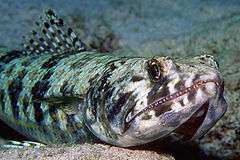Synodontidae
| Lizardfishes Temporal range: Eocene–Recent | |
|---|---|
 | |
| Synodus intermedius | |
| Scientific classification | |
| Kingdom: | Animalia |
| Phylum: | Chordata |
| Class: | Actinopterygii |
| Order: | Aulopiformes |
| Family: | Synodontidae T. N. Gill, 1862 |
| Genera | |
Lizardfishes[note 1] are benthic (bottom-dwelling) marine and estuarine bony fishes that comprise the aulopiform fish family Synodontidae. They are found in tropical and subtropical marine waters throughout the world.
Lizardfishes are generally small, although the largest species measures about 60 cm (24 in) in length. They have slender, somewhat cylindrical bodies, and heads that superficially resemble those of lizards. The dorsal fin is located in the middle of the back, and accompanied by a small adipose fin placed closer to the tail.[2] They have mouths full of sharp teeth, even on the tongue.[1]
Lizardfishes are benthic animals that live in shallow coastal waters; even the deepest-dwelling species of lizardfish live in waters no more than 400 m (1,300 ft) deep. Some species in the subfamily Harpadontinae live in brackish estuaries. They prefer sandy environments, and typically have body colours that help to camouflage them in such environments.[2]
The larvae of lizardfishes are free-swimming. They are distinguished by the presence of black blotches in their guts, clearly visible through their transparent, scaleless, skin.
Taxonomy
Three genera of Synodontidae are known to inhabit the western Atlantic including, Synodus, represented by 6 species, Saurida, represented by 4 species, and Trachinocephalus, represented by a single species.[3] The 6 species comprising the genus Synodus are Synodus intermedius, Synodus saurus, Synodus synodus, Synodus foetens, Synodus bondi and Synodus macrostigmus.[3] The 4 species comprising the genus Saurida are Saurida umeyoshii, Saurida pseudotumbil, Saurida undosquamis and Saurida tumbil. The single species of Trachinocephalus is Trachinocephalus myops. The extinct Argillichthys is represented only by a single species, A. toombsi, from the Eocene-aged London Clay Formation.[2]
See also
- Bombay duck
- Deepsea lizardfish
- USS Lizardfish (a US submarine)
Notes
- ↑ (or typical lizardfish to distinguish them from the Bathysauridae and Pseudotrichonotidae)
References
| Wikimedia Commons has media related to Synodontidae. |
- 1 2 Froese, Rainer, and Daniel Pauly, eds. (2008). "Synodontidae" in FishBase. December 2008 version.
- 1 2 3 Johnson, R.K. & Eschmeyer, W.N. (1998). Paxton, J.R. & Eschmeyer, W.N., eds. Encyclopedia of Fishes. San Diego: Academic Press. pp. 123–124. ISBN 0-12-547665-5.
- 1 2 Benjamin W. Frable; Carole C. Baldwin; Brendan M. Luther & Lee A. Weigt (March 2013). "A New Species of Western Atlantic Lizardfish (Teleostei: Synodontidae: Synodus) and Resurrection of Synodus bondi Fowler, 1939, as a Valid Species from the Caribbean with Redescriptions of S. bondi, S. foetens (Linnaeus, 1766), and S. intermedius (Agassiz, 1829)" (PDF). Fish. Bull. 111 (NMFS Fishery Bulletin): 122–146. doi:10.7755/FB.111.2.2.